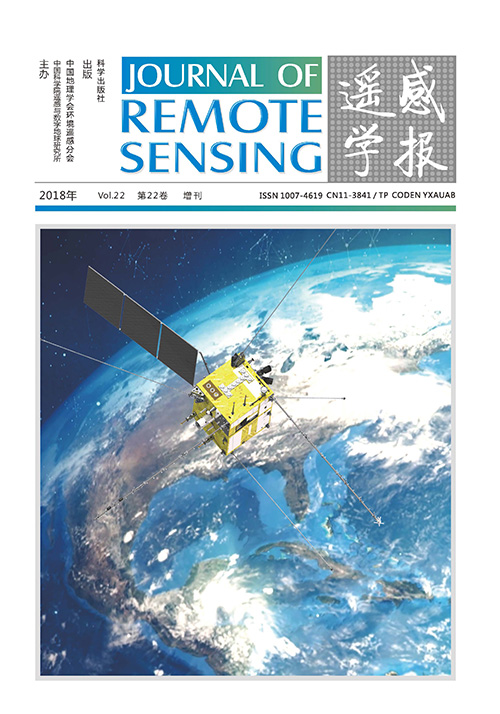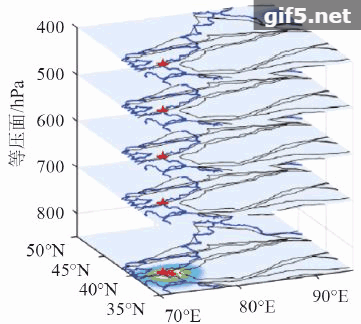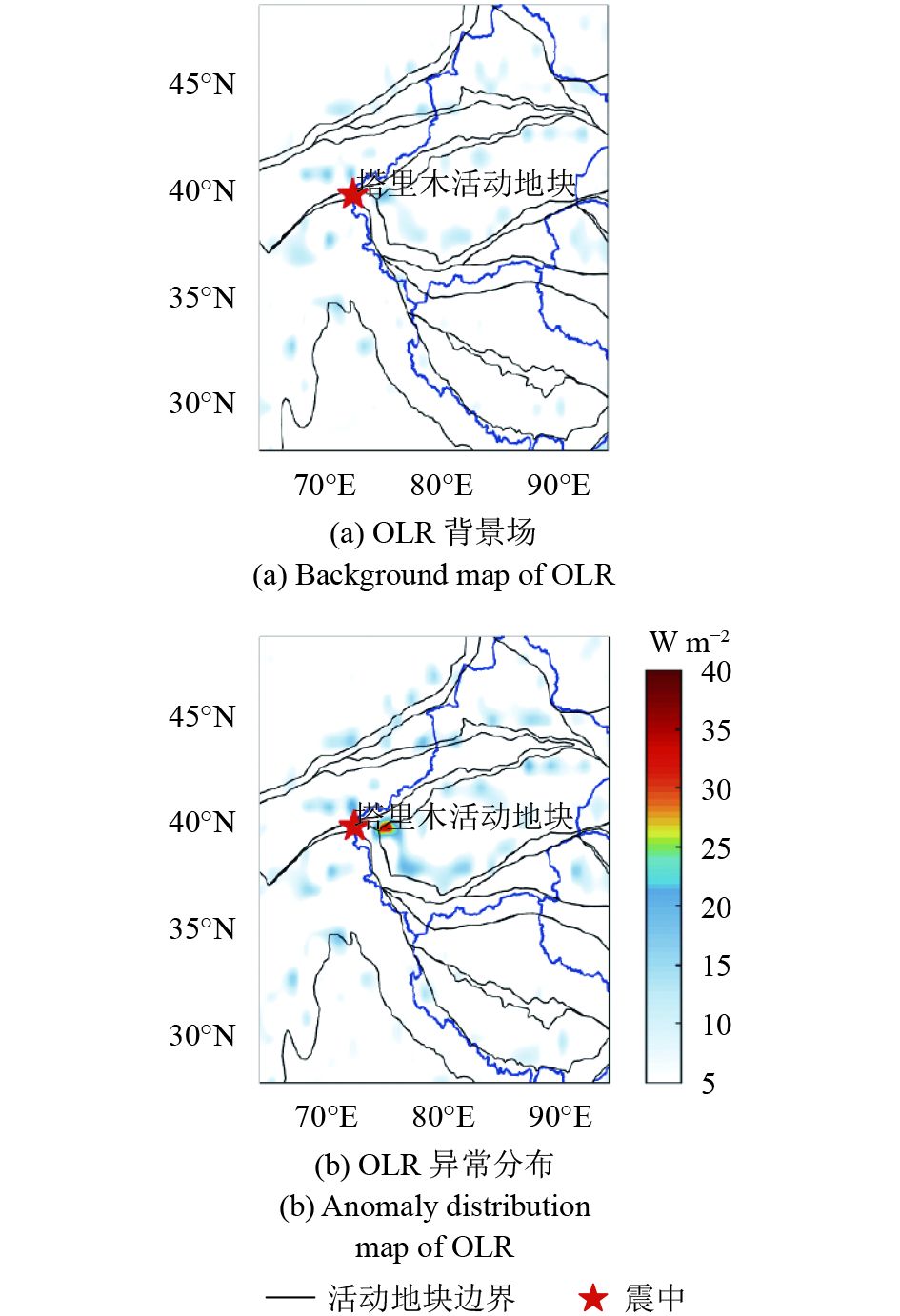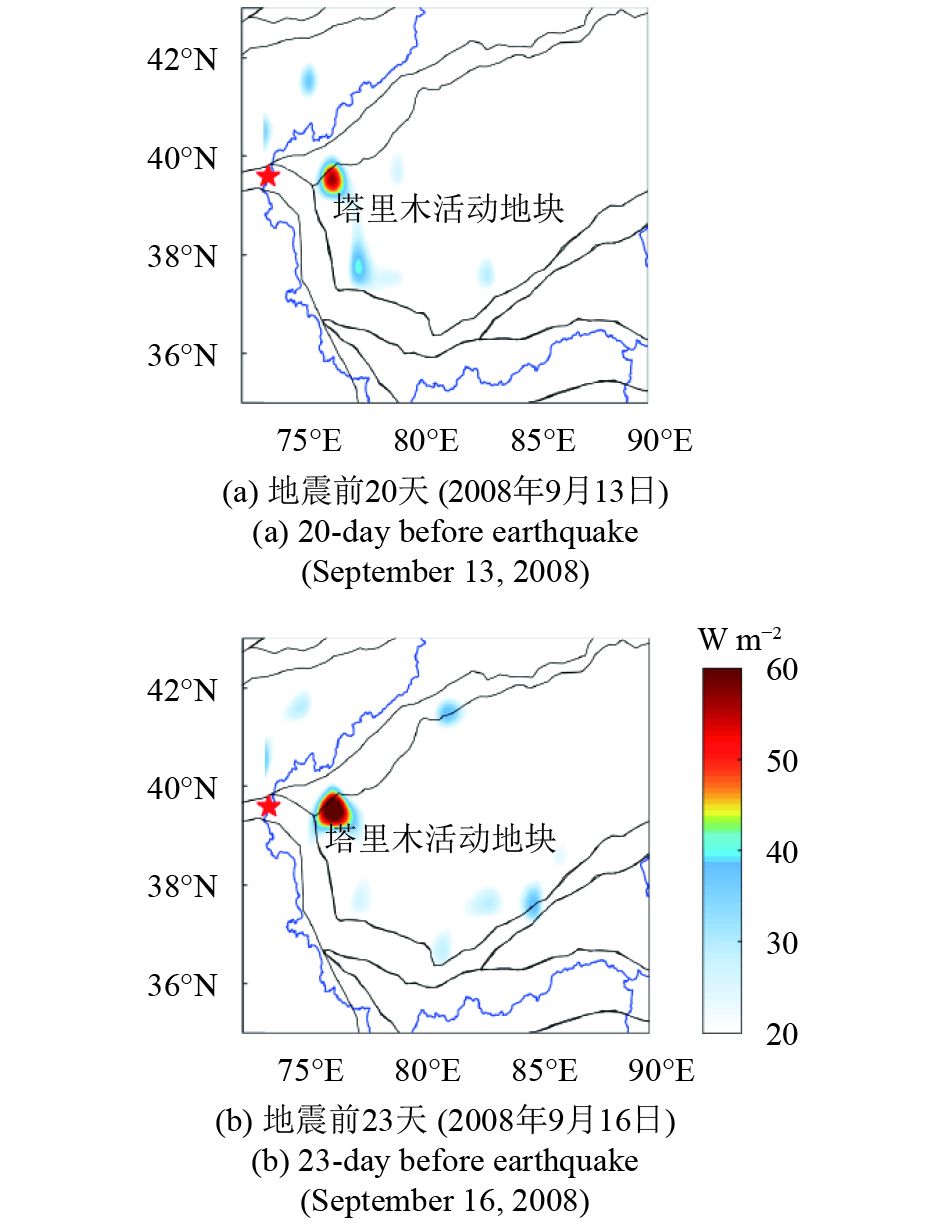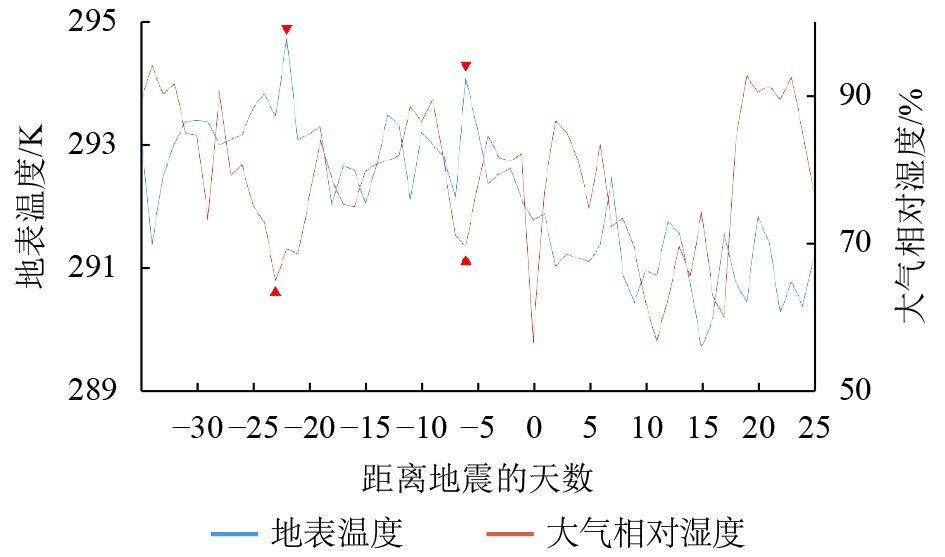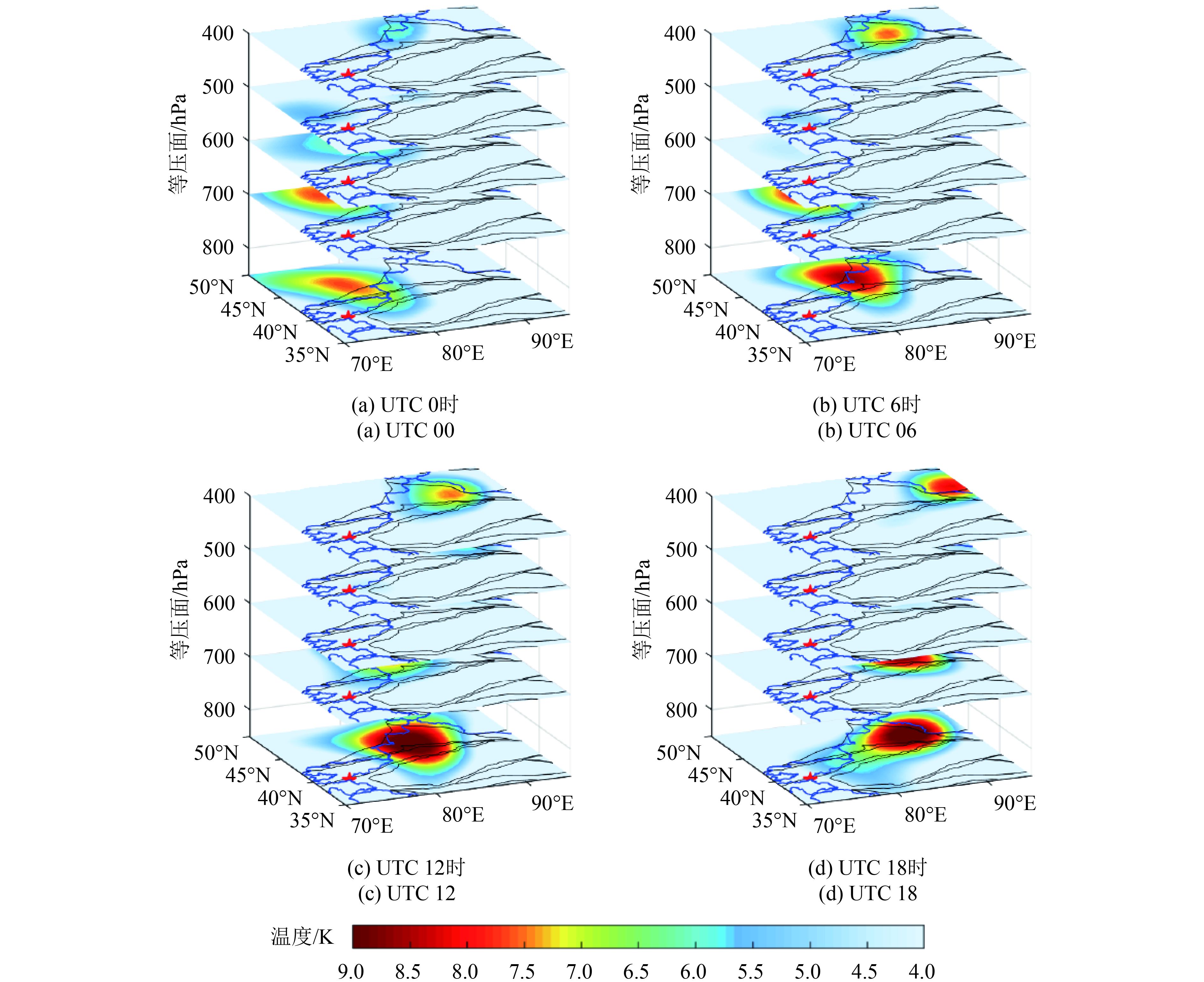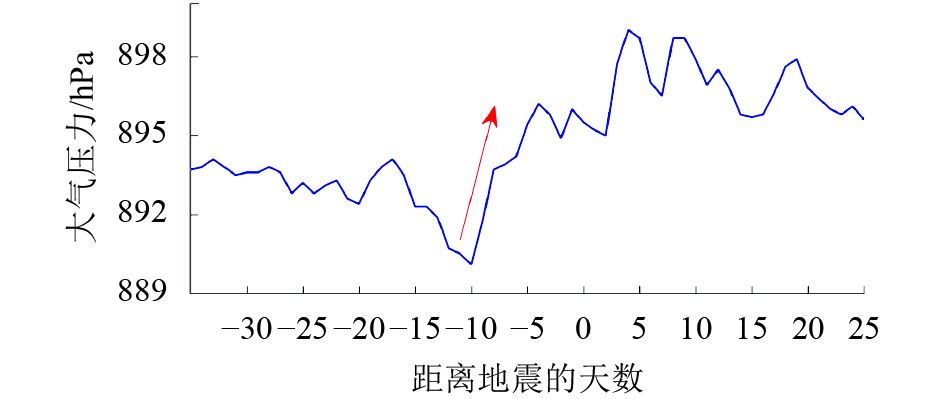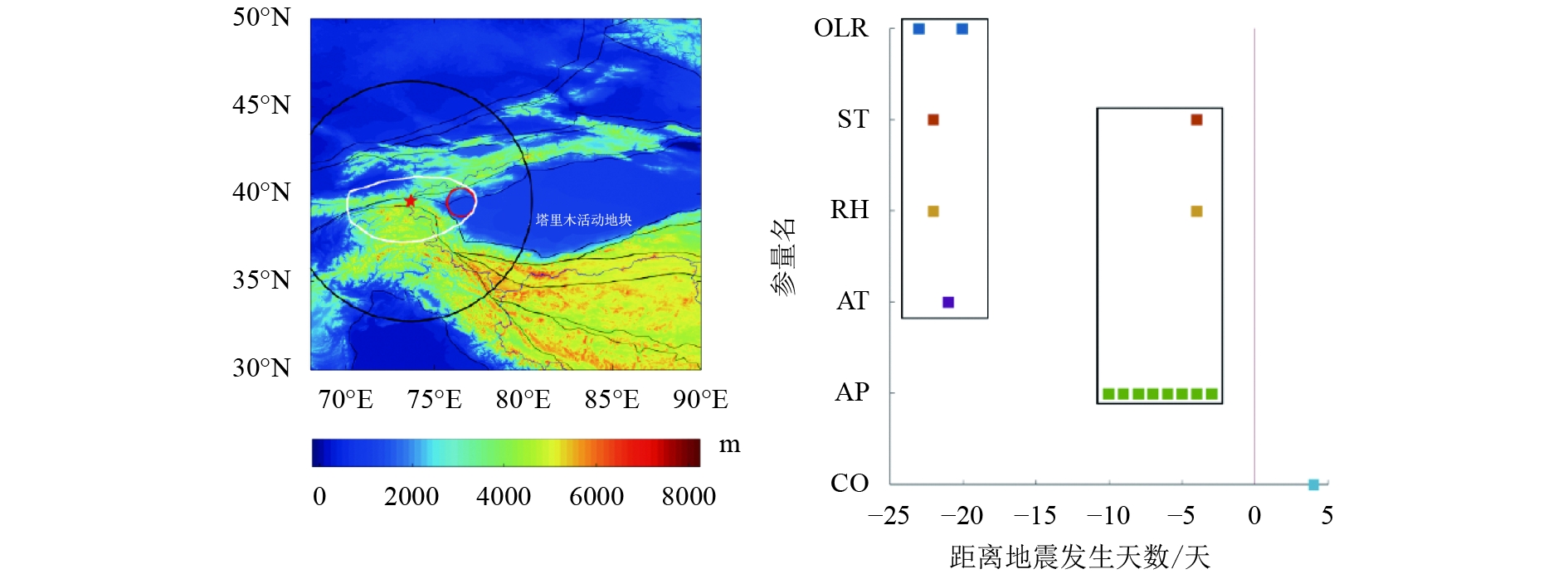|
收稿日期: 2017-06-09
基金项目: 国家自然科学基金(编号:41604062);中国地震局地震预测研究所基本科研业务费专项(编号:2017IES0403,2017IES0306)
第一作者简介: 荆凤,1979年生,女,副研究员,研究方向为卫星遥感地震监测应用。E-mail:jennyfer1111@163.com
中图分类号: TP79
文献标识码: A
|
摘要
研究与孕震过程相关的多种地球物理和地球化学参量的变化特征,可为进一步理解孕震过程中不同圈层多参数的耦合机理提供依据。基于NOAA卫星观测资料分析了2008年乌恰M6.7级地震前后长波辐射异常变化,根据异常时空特征与地震时空窗的对应关系检测到震前的长波辐射异常信息。结合卫星观测获得的地气系统地表温度、大气温度、大气相对湿度、大气压力、一氧化碳含量等地球物理和地球化学参量,基于DTS(Deviation-Time-Space)准则开展了多参量综合分析。结果表明,长波辐射异常点位上的地表温度、大气温度及大气相对湿度在地震前存在耦合关系,而检测到的一氧化碳异常出现在震后4 d,这可能与本次地震的断层特性及震后余震频发有关。此外,震前5—10 d出现的大气压力突变也可能对地震发生起到触发作用。因此,建议将地气系统中长波辐射的异常变化看作与地震活动相关的重要参量,其他地气系统参量作为辅助参量,在未来的地震监测研究中应重视多参量间的耦合及关联性研究。
关键词
长波辐射, 岩石圈—大气层耦合, 多参量, 地震监测, 卫星观测
Abstract
Seismic thermal anomalies have attracted increasing attention from the scientific community since they were proposed in the mid-1980s. A long-term Outgoing Longwave Radiation (OLR) data set from 2007 to 2016 was used to analyze thermal anomalies in the magnitude 6.7 earthquake that hit Wuqia, China, on October 5, 2008. To identify the earth–atmosphere system’s multiple parameter variations related to earthquakes, other surface and atmospheric multi-parameter data were processed over the critical region of Thermal Infrared Radiation (TIR) anomalies. Nighttime NOAA OLR data were selected because capturing seismic anomalies at night is easier than in the daytime considering the effect of artificial anomalies and solar radiation. The vorticity method was used in this study. To reliably detect seismic precursory information, 2009—2011 data on the absence of significant seismic activity in the Xinjiang region were calculated as background field. Apart from vorticity spatial analysis, time series analysis was utilized in this study. Then, the coupling variation of multi-parameter data was analyzed according to the Deviation–Time–Space (DTS) method. The 10-day average OLR vorticity analysis shows a sudden increase of OLR in mid-September 2008. Moreover, a long-term OLR data analysis showed that the anomalies existed prior to the seismic case only, which can be considered a unique variation. The OLR anomalies were not observed in aseismic years, thereby showing that OLR anomalies were related to the Wuqia earthquake. The OLR anomaly is located on the boundary of the Tarim active block. Therefore, distinguishing the seismic precursor is important. The strong-body earthquake-generating model indicates that the irregular boundary of a solid block is likely to accumulate stress. The Tarim tectonic block has been stable since the Cenozoic era and can be classified as a solid body. Previous studies have shown a strong correlation between stress changes and TIR. The enhanced TIR between the active blocks was due to non-continuous stresses and high energy accumulation induced by the interaction of the active blocks and the strong differential movement between them. The increasing TIR anomalies prior to the earthquake led to heat accumulation on the near-surface and the near-ground air, resulting in the variation of skin temperature, air temperature at the lower height pressure levels, and relative humidity of air. The behavior indicates the coupling relationship between the lithosphere and the atmosphere in the seismogenic region. We deduce that air pressure is one of the external trigger factors of earthquakes. The dramatic variation of air pressure during the seismogenic process might affect the critical state. As soon as all internal conditions (the active seismic structure, the nature of the seismogenic zone, the crustal stress environment, and the focal mechanism) exist, some external conditions may trigger an earthquake. The increase in CO degasing in this case is only at the 800 hPa pressure level, thereby indicating that the source of CO variation is mainly the near-ground surface over the seismogenic zone and appears four days after the shock. The post-seismic variation might be related to the nature of seismogenic structure (locked and extrusion pressure-controlled) and the aftershocks. The surface and atmosphere multi-parameter variations associated with the 2008 M6.7 Wuqia earthquake were analyzed to detect precursor information related to the earth–atmosphere system. OLR anomalies were detected on the boundary of the Tarim active block because stress easily accumulated along a solid block boundary. The enhanced TIR emissions are reflected in anomalous OLR data. Results showed that the spatial location of OLR anomalies could reflect the crustal stress accumulation. Furthermore, OLR, skin temperature, air temperature, and relative humidity showed quasi-synchronous variations before this case. Results supported the seismic multi-sphere coupling model. The multi-parameter coupling between the surface and the atmosphere is an important precursor indicator in the short-term and immediate periods, and should be considered in future seismic infrared monitoring.
Key words
outgoing longwave radiation, lithosphere–atmosphere coupling, multiple parameters, earthquake monitoring, satellite observation
1 引 言
地震,特别是大地震前,整个孕震区,甚至是远场区的地气系统将会发生相应的变化,长波辐射数据能够反映出地气系统能量的变化,前人已经利用该数据对许多震例开展了回溯性的分析(Tramutoli等,2005;Ouzounov 等,2007;Jing 等,2009;Rawat 等,2011;Xiong 等,2010;Wu 等,2012a;Venkatanathan和Natyaganov,2014;荆凤 等,2016),检测到地震前出现的长波辐射异常现象。除长波辐射数据外,其他一些参量,如地表温度、大气温度、大气压力、相对湿度等都能在一定程度上反映孕震区地气系统能量的变化情况。近年来,陆续研究分析了地震孕育过程中地气系统不同参量的变化特征及多参量变化的关联性(Pulinet和Dunajecka,2007;Singh 等,2010a;Wu 等,2012a;Jing 等,2013),并建立了多参量地震异常识别的DTS(Deviation-Time-Space)准则,即偏移量上显著、时间上准同步、空间上相邻近的准则(Wu 等,2012a;Qin 等,2013)。基于众多的震例研究结果构建和完善地震多圈层耦合模型(Tronin,2010;Singh 等,2010a;Pulinets和Ouzounov,2011;Wu 等,2012b;Pulinets 等,2015;Wu 等,2016),对于研究孕震机理具有重要意义。但这些针对地震多参数的研究一方面仅重视了数据间的横向比较,而缺少对参量纵向长时间变化的分析;另一方面对地气系统中能够反映大气剖面变化特征的参量缺少对其垂直高度变化特征的分析,特别是对垂直高度变化与地震孕育关联性的分析。
本文以2008年10月5日新疆乌恰M6.7地震为例,在研究长波辐射长时间尺度变化特征的基础上,对地气系统多个地球物理和地球化学参量开展综合分析。基于2007年—2016年共10年的卫星长波辐射数据,从长时间内异常出现的唯一性和异常空间位置与构造的关联性两个角度获取地震时间窗和空间窗的长波辐射异常信息,并结合区内地表—大气多参量数据,对地震前后地气系统不同参量及同一参量在不同高度上的变化特征进行了分析。
2 数据简介
2.1 长波辐射数据
长波辐射是从大气层外观测到的地气系统的对外辐射,是对地表和大气层之间能量状况的一种反映。本研究使用的长波辐射数据为NOAA卫星搭载的红外辐射仪对地球和大气扫描获得的窄通道观测值经比测换算到4—50 μm宽波段的每日1.0°长波辐射数据产品,该产品积累了从2007年至今的全球1.0°网格逐日变化数据,具有完整、连续、稳定、可比性强等特点。长波辐射数据产品的生成采用时间—空间内插法(Liebmann和Smith,1996),该方法对原始数据进行预处理后,再分别对白天观测值和夜晚观测值以先时间内插、后空间内插的顺序来填补缺测值,进而获得全球的观测数据。研究中为了减少太阳辐射和人类活动带来的干扰,选用夜间观测数据。
2.2 再分析气象数据
为了获得与孕震活动有关的大气变化,本研究还使用NCEP(National Center for Environmental Prediction)/NCAR(National Center for Atmospheric Research)再分析数据集中的地表温度、大气温度、大气相对湿度及大气压力逐日产品。该数据集是基于先进的分析系统对不同来源的数据进行同化处理获得的,具有较高的可信度(Kalnay 等,1996)。与传统的地面观测相比,该数据具有高空间分辨率和全球覆盖等优势。
研究使用的地表温度产品的空间分辨率为1.875°(经向)×1.915°(纬向);大气温度、大气相对湿度和大气压力空间分辨率均为2.5°×2.5°,其中大气温度产品包括从10—1000 hPa共17层等压面,4个时刻(UTC 00、06、12、18时)的数据。在物理意义上,地表温度反映的是地球表层的物理温度(Wu 等,2012a),其变化与植被覆盖、云、水汽等密切相关(Jin和Dickinson,2010);大气温度反映的是在地表上空某个高度的温度,近地表大气温度与地表温度具有相关性,且相关性与地表覆盖类型及天空条件有关(Jin和Dickinson,2010)。
2.3 气体地球化学数据
NASA对地观测系统Terra卫星搭载的MOPITT(Measurements of Pollution in the Troposphere)载荷能够对全球大气中的一氧化碳和甲烷气体浓度进行监测并同化生成3维模型,可用于研究低层大气层中的地球化学动力学过程(Drummond和Mand,1996)。考虑到CO含量变化与地震及构造活动的关系(姚清林 等,2005;崔月菊 等, 2011, 2016;孙玉涛 等,2014),本研究使用MOPITT观测获得的CO柱含量数据和CO混合浓度剖面数据,其中CO混合浓度剖面数据包含大气层以100 hPa为间隔从100—900 hPa共9个垂直压力层的数据。
3 数据处理及结果分析
3.1 长波辐射数据变化特征
涡度算法可以获得某个点相对于周围其他点的变化特征,利用此算法计算该区域地震前后长波辐射的10日平均涡度,计算公式如下:
| $\begin{array}{c}V\left({{D_i}, {D_ j}} \right) = OLR\left({{D_i}, {D_j}} \right) \times 4 - \\\left[ {OLR\left( {{D_{i - 1}},{D_j}} \right) + OLR\left( {{D_{i + 1}},{D_j}} \right) + } \right.\\\left. {OLR\left( {{D_i},{D_{j - 1}}} \right) + OLR\left( {{D_i},{D_{j + 1}}} \right)} \right]\end{array}$ | (1) |
式中,
为了检测与地震相关的异常信息,选取没有大于6级以上地震发生的2009年—2011年共3年数据作为背景数据,计算该区域的10日平均涡度背景场。通过对比地震发生年份与相同时期的背景数据,发现在2008年9月11日—20日(震前20天左右)平均涡度变化场内出现显著的长波辐射异常,异常分布在塔里木活动地块西边界距离本次地震最近的位置(图1)(张国民 等,2005)。
为了分析该异常是否与地震活动存在关联性,计算该异常点位上2007年—2016年共10年的长波辐射10日滑动平均时序变化(图2(a)),由图2(a)可知,在10年的时间尺度上长波辐射仅在本次地震之前出现显著增强,超过了10年数据平均值与3倍标准偏差之和的阈值线。因此推测这次长波辐射增强现象与乌恰地震的发生存在关联性。而对长波辐射逐日变化分析结果(图2(b))则显示增强出现在地震前第20天和第23天,长波辐射在这两天出现突跳增强后很快恢复平静。图3为震前20天和23天长波辐射异常的空间分布位置,可以看到在大的区域范围内,仅在该点位出现了长波辐射异常现象,说明该异常并不是由区域性的气象变化产生的。
3.2 地表温度、大气温度及大气相对湿度变化特征
由于地震孕育会影响到整个孕震区地气系统的变化,在开展长波辐射异常与地震活动关系的研究时,应重视孕震区内地气系统其他物理参量的变化特征。因此,本研究还对孕震区内长波辐射异常点位上的地表温度、大气温度及大气相对湿度的变化情况进行了分析。
图4为地震前后地表温度和大气相对湿度的日变化,可以看到地表温度在震前22天和震前4天出现显著的增强,且这两次增强分别对应于大气相对湿度的较低值(图4中红色三角所示)。值得关注的是,在1985年墨西哥Michoacan 8.1级地震和2008年汶川8.0级地震前也曾观测到类似的现象(Pulinets和Dunajecka,2007;Jing 等,2013)。
此外,为了进一步研究检测到的热异常变化的主要来源,又选取不同高度等压面(850 hPa、700 hPa、600 hPa、500 hPa、400 hPa)上的大气温度数据分析地震前后大气温度异常变化的垂直分布(图5)。结果发现,在地震前21天震中区域存在显著的大气温度增强现象,且该增强仅出现在0时刻(UTC)850 hPa的等压面上,而850 hPa等压面正是最靠近地表的大气等压面,在这一天其他时刻(6时、12时、18时)观测到的大气温度垂直变化中并未发现类似的现象。按照时区划分,UTC 0时刻对应于乌恰地方时约凌晨5点,这说明促使低层大气出现的温度增强现象的主要来源不是太阳辐射,而应该是地下深部的热活动,而这种热活动可能与地震构造活动加剧以及与其相关的应力作用存在关联。
在识别地震热异常时应特别注意地下构造活动引起大气温度异常与非震活动带来的大气温度变化的区别。通过对本区域大气温度异常垂直分布的扫描分析(图6),发现非震活动引起的大气异常垂直多出现在同一天的4个时刻,而非仅出现在夜间或凌晨,并且异常会出现在多个等压面相近的空间位置上。根据这一特征,可以判断造成此类异常的源来自于地球外部而非地球内部的构造活动。
3.3 大气压力变化特征
大气压力是另外一种重要的反映地气系统变化的参量,基于地面台站观测的相关结果已经表明地震发生前可能会出现大气压力的显著变化(叶民权,1987;赵芦山,1988;Chadha 等,2003)。对1966年—1976年邢台、海城、龙陵、唐山、松潘、炉霍等地震的研究发现地震常发生在气压呈持续性变化达到最大值或稍后的时间上(马宗晋 等,1982)。基于NCEP/NCAR再分析资料中的大气压力数据也发现了2008年汶川地震前大气压力的突变现象(Jing 等,2013),因此认为不能排除孕震过程中大气压力突变对地震可能产生的触发作用。
图7为利用NCEP/NCAR再分析资料获得的本次地震前后的大气压力变化,可以看到在地震前3—10天大气压力出现6 hPa的提升(图7红色箭头所示),而叶民权(1987)和赵芦山(1988)基于地基观测资料在本区域1985年乌恰M7.4级地震(图8(a))和1955年乌恰M 7.0级地震(图8(b))两个历史地震前也发现了类似的现象。据此推测大气压力变化可能是地震发生的一个外部条件,可将孕震区大气压力的显著变化看作是对地震发生的一种触发,而是否能够触发地震还与地震构造活动、孕震区特征、震源机制等密切相关。
3.4 气体地球化学变化特征
地震孕育引起的应力变化会进一步引起地下气体的变化,许多地基观测结果均显示地震活动前后会出现土壤气(Rn,CO2,CH4,He等)浓度的异常变化(Walia 等,2009;Zhou 等,2010)。本研究通过分析MOPITT卫星观测到的孕震区CO柱含量和CO垂直剖面数据获得了乌恰地震前后孕震区CO变化情况。为了避免白天人类生产活动等可能带来的干扰影响,选取了夜间CO数据开展研究。
地震前后CO柱含量变化如图9(a),可以看到CO柱含量的最高值出现在震后4 d,而CO在不同压力面(800 hPa,700 hPa,600 hPa,500 hPa,400 hPa,300 hPa,200 hPa)混合比的变化显示出在震后4天在最靠近地面高度800 hPa等压面上出现最大值,而这一天在其他高度层则表现为低值(图6(b)),表明CO异常来源于孕震区近地表的贡献,与地震活动关系密切。这与Singh等人(2010b)对2001年Gujarat地震及崔月菊等人(2011)对墨西哥下加利福尼亚地震CO的分析结果相一致。
4 讨 论
通过对2008年乌恰M6.7级地震地表—大气层多参量(长波辐射、地表温度、大气温度、大气相对湿度、大气压力、一氧化碳含量)的分析表明,地震前后多种地球物理和地球化学参量均出现了异常变化。
长波辐射反映的是大气层顶部的辐射信息,包含了地表、大气层以及云顶的辐射状况,是对整个地气系统热动力过程的一种反映,它的异常变化可能预示着整个孕震区热动力过程的异常变化。在地震孕育的过程中,主要构造带的运动可能会使得其上空的大气辐射状况发生变化,这种变化能够在长波辐射数据中得到反映。本次地震长波辐射异常出现在震前20 d左右,且通过对2007年—2016年共10年数据的分析表明特征点位上显著的长波辐射增强仅出现在本次地震前,显示了其在时间上与地震发生的时间窗具有很好的对应关系;而从异常出现的空间位置来看,异常位于塔里木活动地块西边界最靠近本次地震震中的位置,这一空间分布特征对于识别地震异常至关重要。这次地震发生在塔里木活动地块西缘,塔里木地块属于坚固的活动地块,坚固体的不规则边界通常更有利于应力积累和产生地震(刘明军 等,2011)。前人的研究表明应力变化和红外异常之间存在一定的关联性(Brady和Rowell,1986;Saraf等,2009),本文检测到的2008年乌恰地震前塔里木活动地块边界出现的长波辐射异常反应了活动地块间强烈的差异运动及相互作用产生的应力和能量积累。
在孕震区的热动力过程中,整个地表—大气层之间的能量交换加剧,引起了地表及近地表大气的增温,从而导致大气密度减小,产生局部低气压。同时,由于低层大气温度的升高,加剧了地表水汽的蒸发,大气中的水汽自由分子减少,大气相对湿度发生下降。这些多参量的近同步变化显示出地震孕育过程中孕震区岩石圈和大气层之间存在强烈的耦合关系和相互作用。此外,大气压力可以看作是一种触发地震的外部因素,在其他外界条件如断层活动、孕震区环境、震源机制允许的条件下,大气压力的突变可能打破临界状态触发地震。Ganguly(2009)认为震前出现的低气压也可能与地表及大气温度变化引发的重力波有关。
本次地震检测到的CO增高并未出现在震前而是震后,分析认为可能与本次地震的震源机制有关,根据哈佛大学给出的震源机制解显示此次地震为逆断层性质,属于挤压型地震,且震前断层处于闭锁状态(乔学军 等,2014)。孕震过程断层挤压受力产生的应力集中可能会对地下深部气体的上升通道产生影响,阻碍地壳及上地幔地球化学气体上升到地表和低层大气。如2008年发生在龙门山断裂带的汶川地震为高角度逆冲型地震,震前应力高度集中,断层闭锁,震前并未检测到明显的地球化学气体增强,震后由于大量破裂的产生,打开了地下气体释放的通道,出现显著的CH4和CO增高现象(崔月菊 等,2016;Cui 等,2017)。此外,本次地震震后20 d内发生余震3000多次,特别是震后又接连发生2个6级以上余震(李志海 等,2008),也为震后地下气体的释放创造了条件。
本研究仅对长波辐射数据进行了长时间序列分析,是由于长波辐射反映的是整个地气系统的综合变化特征(荆凤 等,2015),受地面其他因素的干扰小于地表温度、大气温度、地球化学气体等地球物理和地球化学参量。开展地震监测研究时,可将长波辐射看作一种指示地震前兆的参数,当某个区域长波辐射数据发生显著变化时,再对这一时间段内地气系统的其他多参量数据进行分析,多参量的耦合变化相比单个参量的异常更为可靠,更能反映孕震区地气系统的综合异常变化。此外,本区域在2016年11月26日还发生了阿克陶M6.6级地震,但并未检测到此次地震前的长波辐射异常现象,分析可能与这次地震的震源机制有关。陈顺云等人 (2009)岩石力学试验结果显示,岩石在挤压作用下温度升高,拉张力作用下温度降低,根据震源机制解,阿克陶地震属于拉张型地震,没有检测到热异常信息是可能的。
根据地震多参量异常识别的DTS准则(Wu 等,2012a;Qin等,2013),对文中各种异常出现的时空特征进行了梳理。根据不同震级地震孕震区半径的计算公式(Dobrovolsky 等,1979)可以获得本次地震的孕震半径约为760 km,本文所检测到的所有异常信息均分布在此范围内(图10中黑圈区域)。其中长波辐射、地表温度、大气压力等的异常变化分布范围较小,主要集中于塔里木活动地块西侧最靠近震中位置的区域内(图10中红圈区域),而大气温度异常空间范围较大(图10中白圈区域),主要以震中为中心向四周扩散分布,且覆盖了其他异常变化的空间范围。在时间方面,震前长波辐射(OLR)、地表温度(ST)、相对湿度(RH)、大气温度(AT)、大气压力(AP)以及一氧化碳(CO)异常的出现分为两个阶段,震前20—23 d和震前3—10 d,每个阶段均出现3种及以上参量的异常,具有近同步性,这符合DTS准则中对地震多参量异常时空特征的表述。
5 结 论
本文基于卫星遥感观测数据分析了2008年10月5日新疆乌恰M6.7级地震前后地气系统多参量(长波辐射、地表温度、大气温度、大气相对湿度、大气压力、一氧化碳含量)的变化特征。研究表明,本文检测到的出现在塔里木活动地块西边界的长波辐射异常与2008年乌恰地震孕震期活动地块边界的应力集中和能量积累有关。基于此进一步利用多参量地震异常识别准则对孕震区多种地球物理和地球化学参量的变化特征进行综合分析,并获得了大气温度和CO在垂直高度上的异常分布,认为异常变化应主要来自于地下构造活动或近地表的贡献。综合分析结果显示了在震前20—23 d和震前3—10 d两个阶段孕震区出现了多参量异常近同步的耦合变化。因此,今后在利用卫星红外数据开展地震异常与非震异常的识别时,除了异常在空间分布上的孤立性、时间分布上的连续性外,还应包括孕震区地气系统多参量异常变化的耦合和近同步性。
开展天—空—地一体的多平台、多手段、多圈层综合立体观测研究应是未来地震监测发展的一个重要方向。多参数多手段的综合分析能够提高地震异常识别的准确性和可信度,同时有助于更深入地理解孕震及发震机理。地震孕育的复杂性决定了地震前兆信息的复杂性,如何准确地捕捉到这些信息还有许多工作要做,本文仅是在深入分析卫星长波辐射与地震孕育关系的基础上开展了其他地气系统多参数的初步分析,虽然获得了多参量的耦合变化,但对各个参量之间变化的关联性以及地气多参量耦合对不同发震环境、不同震源机制地震的响应特征仍需开展进一步的研究。
志 谢 美国国家海洋和大气管理局地球系统研究实验室提供极轨长波辐射数据;美国国家环境预测中心提供地表温度、大气温度、相对湿度、大气压力数据;NASA大气科学数据中心提供MOPITT一氧化碳数据。
参考文献(References)
-
Brady B T and Rowell G A. 1986. Laboratory investigation of the electrodynamics of rock fracture. Nature, 321 (6069): 488–492. [DOI: 10.1038/321488a0]
-
Chadha R K, Pandey A P and Kuempel H J. 2003. Search for earthquake precursors in well water levels in a localized seismically active area of reservoir triggered earthquakes in India. Geophysical Research Letters, 30 (7): 69 [DOI: 10.1029/2002GL016694]
-
Chen S Y, Liu L Q, Liu P X, Ma J and Chen G Q. 2009. Theoretical and experimental study on relationship between stress-strain and temperature variation. Science in China Series D: Earth Sciences, 39 (10): 1446–1455. [DOI: 10.1007/s11430-009-0183-z] ( 陈顺云, 刘力强, 刘培洵, 马瑾, 陈国强. 2009. 应力应变与温度响应关系的理论与实验研究. 中国科学(D辑: 地球科学), 39 (10): 1446–1455. [DOI: 10.1007/s11430-009-0183-z] )
-
Cui Y, Ouzounov D, Hatzopoulos N, Sun K, Zou Z and Du J. 2017. Satellite observation of CH4 and CO anomalies associated with the Wenchuan MS8.0 and Lushan MS7.0 earthquakes in China. Chemical Geology, [DOI: 10.1016/j.chemgeo.2017.06.028]
-
Cui Y J, Du J G, Zhou X C, Chen Z, Li Y, Liu L, Xie C and Zhang W B. 2011. Geochemical anomaly of CO remote sensing associated with Baja California MW7.2 earthquake in Mexico . Bulletin of Mineralogy, Petrology and Geochemistry, 30 (4): 458–464. [DOI: 10.3969/j.issn.1007-2802.2011.04.014] ( 崔月菊, 杜建国, 周晓成, 陈志, 李营, 刘雷, 谢超, 张炜斌. 2011. 墨西哥下加利福尼亚MW7.2地震前后CO遥感地球化学异常 . 矿物岩石地球化学通报, 30 (4): 458–464. [DOI: 10.3969/j.issn.1007-2802.2011.04.014] )
-
Cui Y J, Du J G, Li Y and Guo Q N. 2016. Detecting anomalies of atmospheric total column CH4 and CO related to the 2008 Wenchuan MS8.0 and 2013 Lushan MS7.0 earthquakes . Bulletin of Mineralogy, Petrology and Geochemistry, 35 (5): 1022–1027. [DOI: 10.3969/j.issn.1007-2802.2016.05.023] ( 崔月菊, 杜建国, 李营, 郭秋娜. 2016. 探测与2008年汶川MS8.0和2013年芦山MS7.0地震相关的大气CH4和CO异常变化 . 矿物岩石地球化学通报, 35 (5): 1022–1027. [DOI: 10.3969/j.issn.1007-2802.2016.05.023] )
-
Dobrovolsky I P, Zubkov S I and Miachkin V I. 1979. Estimation of the size of earthquake preparation zones. Pure and Applied Geophysics, 117 (5): 1025–1044. [DOI: 10.1007/BF00876083]
-
Drummond J R and Mand G S. 1996. The measurements of pollution in the troposphere (MOPITT) instrument: overall performance and calibration requirements. Journal of Atmospheric and Oceanic Technology, 13 (2): 314–320. [DOI: 10.1175/1520-0426(1996)013<0314:TMOPIT>2.0.CO;2]
-
Ganguly N D. 2009. Variation in atmospheric ozone concentration following strong earthquakes. International Journal of Remote Sensing, 30 (2): 349–356. [DOI: 10.1080/01431160802282862]
-
Jin M L and Dickinson R E. 2010. Land surface skin temperature climatology: benefitting from the strengths of satellite observations. Environmental Research Letters, 5 (4): 044004 [DOI: 10.1088/1748-9326/5/4/044004]
-
Jing F, Gu X F and Shen X H. 2009. Study on outgoing longwave radiation variations associated with strong earthquake//International Conference on Space Information Technology 2009. Bellingham: SPIE: 765113 [DOI: 10.1117/12.855573]
-
Jing F, Shen X H, Kang C L and Xiong P. 2013. Variations of multi-parameter observations in atmosphere related to earthquake. Natural Hazards and Earth System Science, 13 (1): 27–33. [DOI: 10.5194/nhess-13-27-2013]
-
Jing F, Shen X H, Kang C L and Xiong P. 2015. A comparative analysis between land surface temperature and outgoing long wave radiation based on the application of earthquake monitoring. Remote Sensing for Land and Resources, 27 (1): 81–86. [DOI: 10.6046/gtzyyg.2015.01.13] ( 荆凤, 申旭辉, 康春丽, 熊攀. 2015. 基于地震监测应用的地表温度和长波辐射数据对比分析. 国土资源遥感, 27 (1): 81–86. [DOI: 10.6046/gtzyyg.2015.01.13] )
-
Jing F, Shen X H, Wang H, Kang C L and Xiong P. 2016. Infrared characteristics analysis of the 2015 Nepal Ms8.1 earthquake . Acta Seismologica Sinica, 38 (3): 429–437. [DOI: 10.11939/jass.2016.03.010] ( 荆凤, 申旭辉, 王辉, 康春丽, 熊攀. 2016. 2015年尼泊尔Ms8.1地震红外特征分析 . 地震学报, 38 (3): 429–437. [DOI: 10.11939/jass.2016.03.010] )
-
Kalnay E, Kanamitsu M, Kistler R, Collins W, Deaven D, Gandin L, Iredell M, Saha S, White G, Woollen J, Zhu Y, Leetmaa A, Reynolds B, Chelliah M, Ebisuzaki W, Higgins W, Janowiak J, Mo K C, Ropelewski C, Wang J, Jenne R and Joseph D. 1996. The NCEP/NCAR 40-year reanalysis project. Bulletin of the American Meteorological Society, 77 (3): 437–471. [DOI: 10.1175/1520-0477(1996)077<0437:TNYRP>2.0.CO;2]
-
Li Z H, Long P W and Ma H S. 2008. Seismogenic structure and earthquake sequences analysis on Wuqia earthquake with Ms 6.8 on OCT.5 in 2008 . Inland Earthquake, 22 (4): 355–360. [DOI: 10.3969/j.issn.1001-8956.2008.04.009] ( 李志海, 龙鹏伟, 马宏生. 2008. 2008年10月5日新疆乌恰6.8级地震发震构造与地震序列分析. 内陆地震, 22 (4): 355–360. [DOI: 10.3969/j.issn.1001-8956.2008.04.009] )
-
Liebmann B and Smith C. 1996. Description of a complete (interpolated) outgoing longwave radiation dataset. Bulletin of the American Meteorological Society, 77 (6): 1275–1277.
-
Liu M J, Fan J C, Han Y J, Wang S H, Hu Z M, Shen H L and Zhao L. 2011. Relationship between the movements of Ordos and Tarim blocks and strong earthquakes in China continent. Earthquake, 31 (1): 127–134. [DOI: 10.3969/j.issn.1000-3274.2011.01.014] ( 刘明军, 樊计昌, 韩艳杰, 王士华, 胡中民, 莘海亮, 赵丽. 2011. 鄂尔多斯和塔里木地块运动与中国大陆强震关系探讨. 地震, 31 (1): 127–134. [DOI: 10.3969/j.issn.1000-3274.2011.01.014] )
-
Ma Z J, Fu Z X, Zhang Y Z, Wang C M, Zhang G M and Liu D F. 1982. Nine Greatest Earthquakes in China from 1966 to 1976. Beijing: Seismological Press: 117–119 (马宗晋, 傅征祥, 张郢珍, 汪成民, 张国民, 刘德富. 1982. 1966—1976年中国九大地震. 北京: 地震出版社: 117–119)
-
Ouzounov D, Liu D F, Chunli K, Cervone G, Kafatos M and Taylor P. 2007. Outgoing long wave radiation variability from IR satellite data prior to major earthquakes. Tectonophysics, 431 (1/4): 211–220. [DOI: 10.1016/j.tecto.2006.05.042]
-
Pulinets S A and Dunajecka M A. 2007. Specific variations of air temperature and relative humidity around the time of Michoacan earthquake M8.1 Sept. 19, 1985 as a possible indicator of interaction between tectonic plates. Tectonophysics, 431 (1/4): 221–230. [DOI: 10.1016/j.tecto.2006.05.044]
-
Pulinets S A and Ouzounov D. 2011. Lithosphere-atmosphere-ionosphere coupling (LAIC) model-an unified concept for earthquake precursors validation. Journal of Asian Earth Sciences, 41 (4/5): 371–382. [DOI: 10.1016/j.jseaes.2010.03.005]
-
Pulinets S A, Ouzounov D P, Karelin A V and Davidenko D V. 2015. Physical bases of the generation of short-term earthquake precursors: a complex model of ionization-induced geophysical processes in the lithosphere-atmosphere-ionosphere-magnetosphere system. Geomagnetism and Aeronomy, 55 (4): 521–538. [DOI: 10.1134/S0016793215040131]
-
Qiao X J, Wang Q, Yang S M and Li J. 2014. Study on the focal mechanism and deformation characteristics for the 2008 Mw6.7 Wuqia earthquake, Xinjiang by InSAR . Chinese Journal of Geophysics, 57 (6): 1850–1813. [DOI: 10.6038/cjg20140612] ( 乔学军, 王琪, 杨少敏, 李杰. 2014. 2008年新疆乌恰MW6.7地震震源机制与形变特征的InSAR研究 . 地球物理学报, 57 (6): 1850–1813. [DOI: 10.6038/cjg20140612] )
-
Qin K, Wu L X, Zheng S and Liu S J. 2013. A deviation-time-space-thermal (DTS-T) method for global earth observation system of systems (GEOSS)-based earthquake anomaly recognition: criterions and quantify indices. Remote Sensing, 5 (10): 5143–5151. [DOI: 10.3390/rs5105143]
-
Rawat V, Saraf A K, Das J, Sharma K and Shujat Y. 2011. Anomalous land surface temperature and outgoing long-wave radiation observations prior to earthquakes in India and Romania. Natural Hazards, 59 (1): 33–46. [DOI: 10.1007/s11069-011-9736-5]
-
Saraf A K, Rawat V, Choudhury S, Dasgupta S and Das J. 2009. Advances in understanding of the mechanism for generation of earthquake thermal precursors detected by satellites. International Journal of Applied Earth Observation and Geoinformation, 11 (6): 373–379. [DOI: 10.1016/j.jag.2009.07.003]
-
Singh R P, Mehdi W, Gautam R, Kumar J S, Zlotnicki J and Kafatos M. 2010a. Precursory signals using satellite and ground data associated with the Wenchuan Earthquake of 12 May 2008. International Journal of Remote Sensing, 31 (13): 3341–3354. [DOI: 10.1080/01431161.2010.487503]
-
Singh R P, Kumar J S, Zlotnicki J and Kafatos M. 2010b. Satellite detection of carbon monoxide emission prior to the Gujarat earthquake of 26 January 2001. Applied Geochemistry, 25 (4): 580–585. [DOI: 10.1016/j.apgeochem.2010.01.014]
-
Sun Y T, Cui Y J, Liu Y M, Du J G, Zhang W B and Zhang G Y. 2014. Remote sensing anomalies of CO and O3 related to two giant Sumatra earthquakes occurred in 2004 and 2005 . Remote Sensing Information, 29 (2): 49–55. [DOI: 10.3969/j.issn.1000-3177.2014.02.009] ( 孙玉涛, 崔月菊, 刘永梅, 杜建国, 张炜斌, 张冠亚. 2014. 苏门答腊2004、2005 年两次大地震前后CO和O3遥感信息 . 遥感信息, 29 (2): 49–55. [DOI: 10.3969/j.issn.1000-3177.2014.02.009] )
-
Tramutoli V, Cuomo V, Filizzola C, Pergola N and Pietrapertosa C. 2005. Assessing the potential of thermal infrared satellite surveys for monitoring seismically active areas: the case of Kocaeli (Izmit) earthquake, August 17, 1999. Remote Sensing of Environment, 96 (3/4): 409–426. [DOI: 10.1016/j.rse.2005.04.006]
-
Tronin A A. 2010. Satellite remote sensing in seismology. A review. Remote Sensing, 2 (1): 124–150. [DOI: 10.3390/rs2010124]
-
Venkatanathan N and Natyaganov V. 2014. Outgoing longwave radiations as pre-earthquake signals: preliminary results of 24 September 2013 (M7.7) earthquake . Current Science, 106 (9): 1291–1297.
-
Walia V, Yang T F, Hong W L, Lin S J, Fu C C, Wen K L and Chen C H. 2009. Geochemical variation of soil-gas composition for fault trace and earthquake precursory studies along the Hsincheng fault in NW Taiwan. Applied Radiation and Isotopes, 67 (10): 1855–1863. [DOI: 10.1016/j.apradiso.2009.07.004]
-
Wu L X, Qin K and Liu S J. 2012a. GEOSS-based thermal parameters analysis for earthquake anomaly recognition. Proceedings of the IEEE, 100 (10): 2891–2907. [DOI: 10.1109/JPROC.2012.2184789]
-
Wu L X, Qin K, Liu S J, De Santis A and Cianchini G. 2012b. Importance of lithosphere-coversphere-atmosphere coupling to earthquake anomaly recognition//2012 IEEE International Geoscience and Remote Sensing Symposium (IGARSS). Munich, Germany: IEEE: 3532–3535 [DOI: 10.1109/IGARSS.2012.6350657]
-
Wu L X, Zheng S, De Santis A, Qin K, Di Mauro R, Liu S J and Rainone M L. 2016. Geosphere coupling and hydrothermal anomalies before the 2009 Mw6.3 L′Aquila earthquake in Italy . Natural Hazards and Earth System Sciences, 16 (8): 1859–1880. [DOI: 10.5194/nhess-16-1859-2016]
-
Xiong P, Shen X H, Bi Y X, Kang C L, Chen L Z, Jing F and Chen Y. 2010. Study of outgoing longwave radiation anomalies associated with Haiti earthquake. Natural Hazards and Earth System Sciences, 10 (10): 2169–2178. [DOI: 10.5194/nhess-10-2169-2010]
-
Yao Q L, Qiang Z J and Wang Y P. 2005. CO release from the Tibetan plateau before earthquakes and increasing temperature anomaly showing in thermal infrared images of satellite. Advances in Earth Science, 20 (5): 505–510. [DOI: 10.3321/j.issn:1001-8166.2005.05.004] ( 姚清林, 强祖基, 王弋平. 2005. 青藏高原地震前CO的排放与卫星热红外增温异常. 地球科学进展, 20 (5): 505–510. [DOI: 10.3321/j.issn:1001-8166.2005.05.004] )
-
Ye M Q. 1987. Anomalous meteorological phenomenon and feature before the earthquake of M=7.4 in Muqia. Northwestern Seismological Journal, 9 (2): 46–51. ( 叶民权. 1987. 乌恰7.4级地震前气象异常征象. 西北地震学报, 9 (2): 46–51. )
-
Zhang G M, Ma H S, Wang H and Wang X L. 2005. Boundaries between active-tectonic blocks and strong earthquakes in the China mainland. Chinese Journal of Geophysics, 48 (3): 602–610. [DOI: 10.3321/j.issn:0001-5733.2005.03.018] ( 张国民, 马宏生, 王辉, 王新岭. 2005. 中国大陆活动地块边界带与强震活动. 地球物理学报, 48 (3): 602–610. [DOI: 10.3321/j.issn:0001-5733.2005.03.018] )
-
Zhao L S. 1988. The interference effects of barometric pressure and its application in earthquake prediction. Inland Earthquake, 2 (2): 157–165. ( 赵芦山. 1988. 大气压力的干扰作用及据其变化预测地震问题. 内陆地震, 2 (2): 157–165. )
-
Zhou X C, Du J G, Chen Z, Cheng J W, Tang Y, Yang L M, Xie C, Cui Y J, Liu L, Yi L, Yang P X and Li Y. 2010. Geochemistry of soil gas in the seismic fault zone produced by the Wenchuan Ms8.0 earthquake, southwestern China . Geochemical Transactions, 11 : 5 [DOI: 10.1186/1467-4866-11-5]
